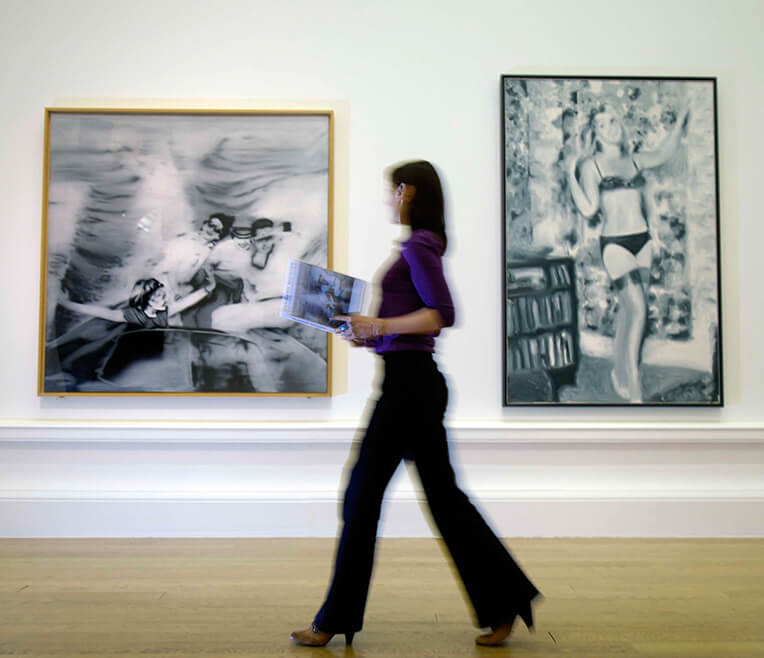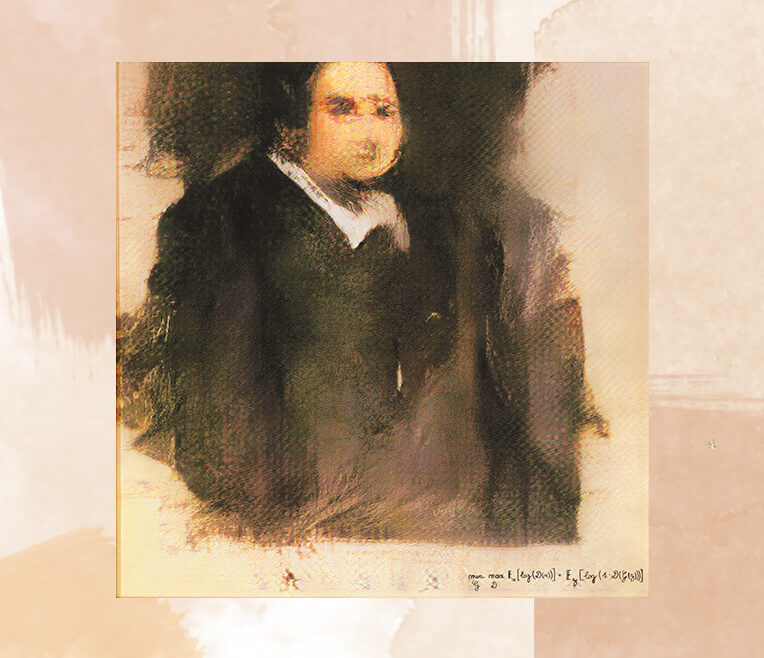
Does the future of art belong to robots?
The portrait »Edmond De Belamy« looks like a relic of an art era resigned to the depths of history. But it was actually created in 2018, using an algorithm developed by a Parisian collective of futurists. Expected to sell for four figures, it eventually fetched nearly half a million dollars at a Christie’s auction. The work represents the world’s first renowned AI-generated »painting«, though the catalogue of art created by neural networks is already much deeper than you probably realize. As automation threatens to disrupt almost every industry in the world, should artists have cause for concern?
- Text: Christian Näthler
Aesthetically, there’s nothing particularly special about »Edmond De Belamy«. It appears to be just another fuzzy portrait from a bygone century. A signature in the bottom-right corner of the canvas, however, reveals it to be markedly contemporary. It is not the pen stroke of an artist but a line of code belonging to the algorithm that produced the work.
In October 2018, »Edmond De Belamy« fetched $432,500 USD at Christie’s. It was billed as “the first piece of AI-generated art to come to auction.”
The artificial intelligence that created the work is credited to a Paris-based collective called Obvious. But unlike art, attribution for code is less linear. The core of the AI that produced the portrait was actually built by another artist, Robbie Barrat. It was published online a year before the auction, where anyone could access, apply, and modify it as they see fit. In the software world, this type of release, in which the copyright holder uploads their work to the public domain, is called open source.
Barrat’s neural network was based on a type of algorithm called a generative adversarial network (GAN). It generated a series of portraits[1] unmistakably similar to what the world came to know as »Edmond De Belamy«. Obvious merely adopted Barrat’s technical infrastructure and made a few tweaks, like Kanye West might in producing a hip-hop beat.
I don’t have the space nor capacity to fully explain how a GAN algorithm works, so let’s use a KitchenAid mixer as a layman’s analogy. Achieving a satisfactory output depends on the quality and selection of the input (the ingredients or, in the case of art, existing images), as well as the competence of the machine. The outcome is a new rendition that’s the sum of its parts. Whereas with a mixer you can taste the various inputs, with GAN art you can see them.
A press release distributed by Obvious to promote »Edmond De Belamy« ahead of the auction made a Buzzfeed-style boast: »An artificial intelligence managed to create art.«[2] This is misleading, much like obscuring who programmed the algorithm. To the uninitiated, those without a background in GAN, or an understanding of kitchen appliances, such a phrase might suggest that AI is an autonomous creative agent. But it takes flesh and blood creatives to curate an algorithm’s input images and decide when a satisfactory output image has been achieved. If you feed it garbage, it will likely produce garbage.
This says nothing of the artistry required to code a program capable of creating respectable art. Sure, you could simply adopt others’ algorithms, a la Obvious, but to be an outstanding artist will mean being able to layer your own script onto existing GAN frameworks. The tool is the masterpiece, not the execution. This is the premise of conceptual art and, beyond that, another reason everyone should learn some code in their free time. Especially artists.
What artists don’t have to worry about is robots coming to replace them. AI is a new tool operating under an existing umbrella. It is not a new kind of artist. While advances in AI will produce increasingly “better” art, the value of art will continue to be determined by market forces that are blind to what’s actually on the canvas. Just because AI will be able to create a more technically impressive “painting,” it won’t necessarily mean that computers are an economic threat.
‘Edmond De Belamy’ is not the first piece of algorithm-generated art. It’s also far from the most impressive (most computer scientists, in fitting parlance, would probably tell you they have an AI that could create that). But it is remarkable for confronting the world’s most prestigious art institution with the problem of attributing open source code. Controversy, after all, is a market force. This probably explains why a portrait that to the eye more closely resembles the infamous ‘Potato Jesus’ than something you’d expect to see in a museum sold for as much as a Picasso at Christie’s.
[1] https://twitter.com/DrBeef_/status/1055285640420483073?ref_src=twsrc%5Etfw%7Ctwcamp%5Etweetembed%7Ctwterm%5E1055285640420483073&ref_url=https%3A%2F%2Fqz.com%2Fquartzy%2F1437876%2Fai-generated-portrait-of-edmond-de-belamy-sold-for-432500%2F
[2] https://cdn.vox-cdn.com/thumbor/oPIZejuX6ct-38ro0LtyG5xPG4o=/0x0:516×735/1720×0/filters:focal(0x0:516×735):format(webp):no_upscale()/cdn.vox-cdn.com/uploads/chorus_asset/file/13318267/Screen_Shot_2018_10_23_at_12.28.34_PM.png






